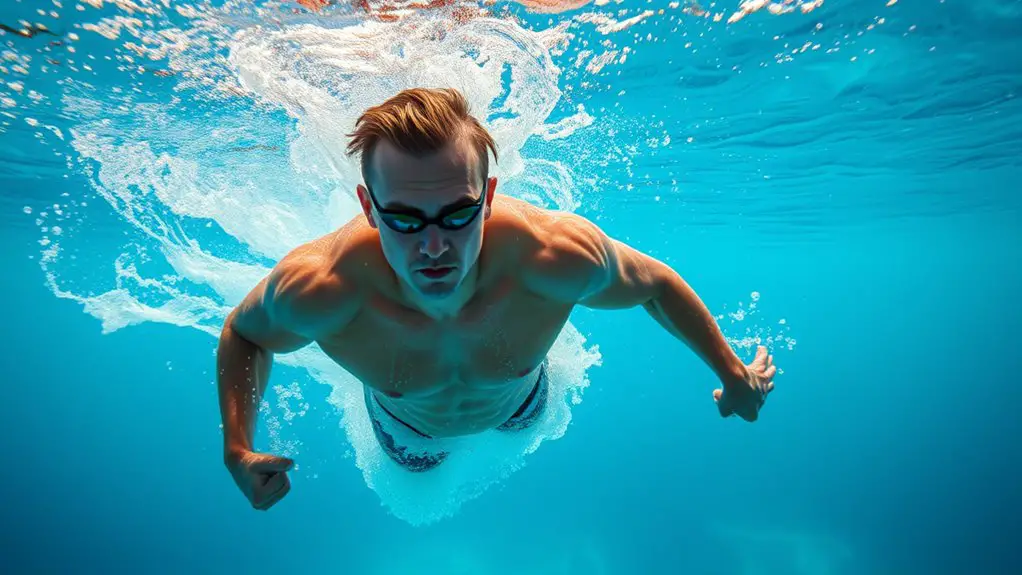Underwater resistance training enhances your power by utilizing water's unique properties, like its density and viscosity. This challenges your muscles dynamically, requiring greater engagement for each movement. The buoyancy plays an essential role by reducing joint impact, allowing you to push harder while minimizing injury risk. Additionally, the variable resistance of water facilitates explosive movements, helping you build strength more effectively. If you're curious, there's much more to discover about how this training can elevate your performance.
The Mechanics of Underwater Resistance
When you plunge into underwater resistance training, you'll quickly notice how water's density creates a unique challenge for your muscles. Unlike traditional weightlifting, where gravity dictates the load, water pushes against you in every direction. This omnidirectional resistance means your muscles must work harder to move, engage, and stabilize, promoting a deeper, more all-encompassing workout.
As you glide through the water, each movement feels liberating yet demanding, pushing you to explore your limits. The natural flow of water allows for fluid, dynamic motions that can't be replicated on land. You'll find your core engages more fully to maintain balance, adding another layer to your training.
In this aquatic environment, you can experiment with various movements, discovering what feels right for your body. Embrace the resistance, and you'll reveal new potential, all while enjoying the freedom of movement that only water can provide.
Benefits of Buoyancy in Strength Training
When you train underwater, buoyancy plays an essential role in your strength workouts. It helps reduce joint impact, making your sessions safer, while also increasing muscle activation for better results. Plus, you'll notice an enhanced range of motion, allowing you to perform exercises more effectively.
Reduced Joint Impact
Although traditional strength training can place significant stress on your joints, underwater resistance training offers a unique solution by leveraging buoyancy. When you're submerged, the water supports your body, reducing the strain on your joints and allowing you to move freely without fear of injury. This supportive environment lets you push your limits while staying safe, making it easier to maintain your workout routine. You'll find that you can focus on building strength without the nagging discomfort often associated with land-based exercises. With this freedom from joint impact, you can explore new movements and challenge yourself in ways that feel empowering and invigorating. Embrace the buoyancy and enjoy the journey towards greater strength without the burden of joint pain.
Increased Muscle Activation
The buoyancy of water not only minimizes joint impact but also enhances muscle activation during workouts. When you immerse yourself in water, your body works against resistance in a unique way, engaging more muscle fibers than traditional land training. This increased activation means you can build strength more effectively while enjoying the freedom of movement that water provides. You'll notice that every stroke or lift feels different, as the water challenges your muscles in all directions. Plus, the feeling of weightlessness gives you the confidence to push your limits without fear of injury. So, embrace the flow and experience how underwater resistance training can elevate your strength and power, allowing you to explore movement in a liberating environment.
Enhanced Range of Motion
Buoyancy in water not only supports your body but also allows for a greater range of motion during strength training. When you're submerged, you can move freely without the constraints of gravity. This freedom lets you explore deeper stretches and full-body movements that might feel restricted on land. Your joints experience less strain, so you can push your limits safely and effectively. Plus, the resistance of water provides a unique challenge, enhancing muscle engagement throughout each motion. You'll find that your body can flow more naturally, leading to improved flexibility and strength. Embracing this fluid environment not only elevates your training but also empowers you to discover your full physical potential. Immerse yourself and feel the difference!
Comparing Underwater Resistance to Traditional Weightlifting
When you compare underwater resistance training to traditional weightlifting, you'll notice some key differences. The variability in resistance you experience in water can enhance your workouts, while also reducing impact on your joints. This makes underwater training an appealing option for those looking to build strength without the strain.
Resistance Variability Benefits
While both underwater resistance training and traditional weightlifting offer unique advantages, the variability in resistance provided by water can enhance muscle engagement and overall effectiveness. Water's natural resistance changes with your movements, meaning you're constantly adapting, which leads to better strength gains.
| Aspect | Underwater Resistance | Traditional Weightlifting |
|---|---|---|
| Resistance Type | Variable | Fixed |
| Muscle Engagement | Dynamic | Static |
| Range of Motion | Free-flowing | Limited |
| Impact on Joints | Gentle | High |
| Overall Experience | Fluid and liberating | Constrained |
Embracing underwater resistance training allows for a more versatile workout, giving you the freedom to explore your physical limits while keeping your muscles engaged and challenged.
Joint Impact Reduction
The unique properties of water not only enhance muscle engagement but also considerably reduce joint impact during workouts. When you immerse yourself in water, the buoyancy supports your body, allowing you to move freely without the heavy toll traditional weightlifting can take on your joints. This means you can push your limits and explore new movements without the fear of injury. Water's resistance works your muscles effectively while cushioning your joints, making it ideal for anyone seeking a safer alternative to conventional training. By choosing underwater resistance training, you're not just building power; you're also promoting your body's longevity. Embrace this liberating approach, and feel the difference as you strengthen your physique without the aches and pains often associated with traditional weightlifting.
Enhancing Muscle Activation Through Water Resistance
As you plunge into underwater resistance training, you'll discover that water offers unique properties that enhance muscle activation. The natural buoyancy allows you to move freely, engaging your muscles in ways that land training often can't. With each stroke and movement, the water's resistance encourages your muscles to work harder, firing up those fibers and boosting your overall strength.
You'll feel the difference as you push against the water's density; it creates a perfect blend of challenge and support. Every time you exert force, your body adapts, recruiting more muscle fibers for the task. This not only enhances muscle activation but also increases endurance and power. Additionally, this kind of training supports core strength development, which stabilizes the spine and reduces the risk of injury.
In this fluid environment, you can tap into a liberating workout experience. You're not just training; you're harnessing the power of water to release your full potential, giving you the freedom to explore your physical limits like never before.
The Role of Viscosity in Explosive Movements
Understanding how viscosity affects explosive movements can greatly enhance your underwater training. Viscosity, or the thickness of water, creates unique resistance that challenges your muscles in ways land training can't. When you push against this resistance, you're not just moving—you're engaging your muscles explosively.
Here are a few ways viscosity impacts your training:
- Increased Resistance: The thicker the water, the harder you have to work, which can lead to greater strength gains.
- Variable Load: As you accelerate your movements, viscosity increases resistance dynamically, simulating real-life explosive motions.
- Muscle Coordination: Training in water forces your body to stabilize and coordinate movements more effectively, enhancing overall power output.
Injury Prevention and Rehabilitation With Underwater Training
While many athletes focus on strength and conditioning, underwater training offers significant benefits for injury prevention and rehabilitation. The buoyancy of water reduces impact on joints, allowing you to strengthen muscles without the stress of traditional workouts. This makes it an excellent option for those recovering from injuries or looking to prevent them. Additionally, proper warm-up techniques can enhance the effectiveness of underwater workouts by preparing muscles for the resistance training involved.
| Benefit | Description | How It Helps |
|---|---|---|
| Reduced Impact | Less strain on joints | Minimizes injury risk |
| Resistance Training | Water's viscosity enhances effort | Builds strength safely |
| Enhanced Mobility | Improved range of motion | Aids recovery and flexibility |
Incorporating underwater workouts into your routine can foster a sense of freedom in movement. You'll not only stay fit but also be proactive in keeping injuries at bay, allowing you to pursue your athletic goals with confidence.
Practical Applications for Athletes in Various Sports
Athletes across various sports can greatly benefit from incorporating underwater resistance training into their routines. This unique training method not only enhances power but also allows for greater freedom in movement while minimizing the risk of injury. Here are some practical applications for different sports:
- Swimming: Boosts stroke efficiency and builds muscle strength without the stress of traditional weight training.
- Running: Improves endurance and speed while reducing impact on joints, allowing for longer training sessions.
- Team Sports: Enhances agility and explosive power, essential for performance in sports like basketball or soccer. Incorporating grip-strength training into underwater workouts can further enhance overall athletic performance.
Frequently Asked Questions
Can Underwater Resistance Training Help With Weight Loss?
Yes, underwater resistance training can help with weight loss. It burns calories efficiently while building muscle, letting you enjoy workouts without the strain of traditional exercises. You'll feel lighter and more energized as you progress.
How Does Temperature Affect Underwater Training Effectiveness?
Temperature can greatly impact your underwater training. Warmer water might relax your muscles, enhancing flexibility, while cooler temperatures can boost endurance. Finding the right balance helps you optimize your training effectiveness and personal comfort.
Is Underwater Training Suitable for All Fitness Levels?
Imagine gliding through water, where every movement feels like flying. Underwater training's versatility makes it suitable for all fitness levels. Whether you're a novice or seasoned athlete, you'll find freedom in its resistance and support.
What Equipment Is Needed for Underwater Resistance Training?
For underwater resistance training, you'll need resistance bands, aquatic dumbbells, or weighted vests. A swim suit's essential too, allowing you to move freely. Don't forget a pool or open water space to enhance your experience!
How Often Should I Practice Underwater Resistance Training?
To keep your training flowing smoothly, aim for two to three sessions per week. This way, you'll strike a balance between building strength and allowing your body to recover, giving you the freedom to progress.




